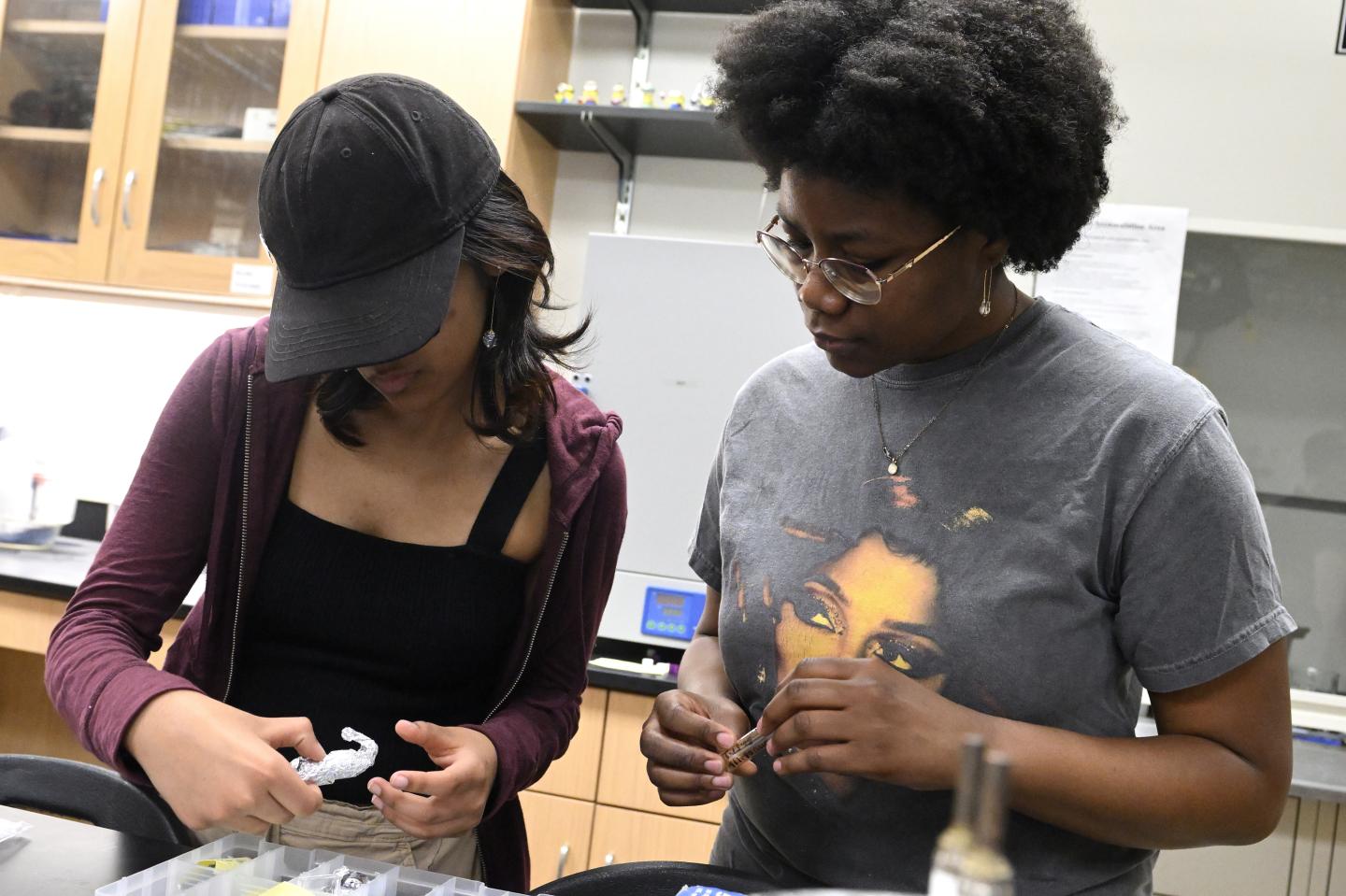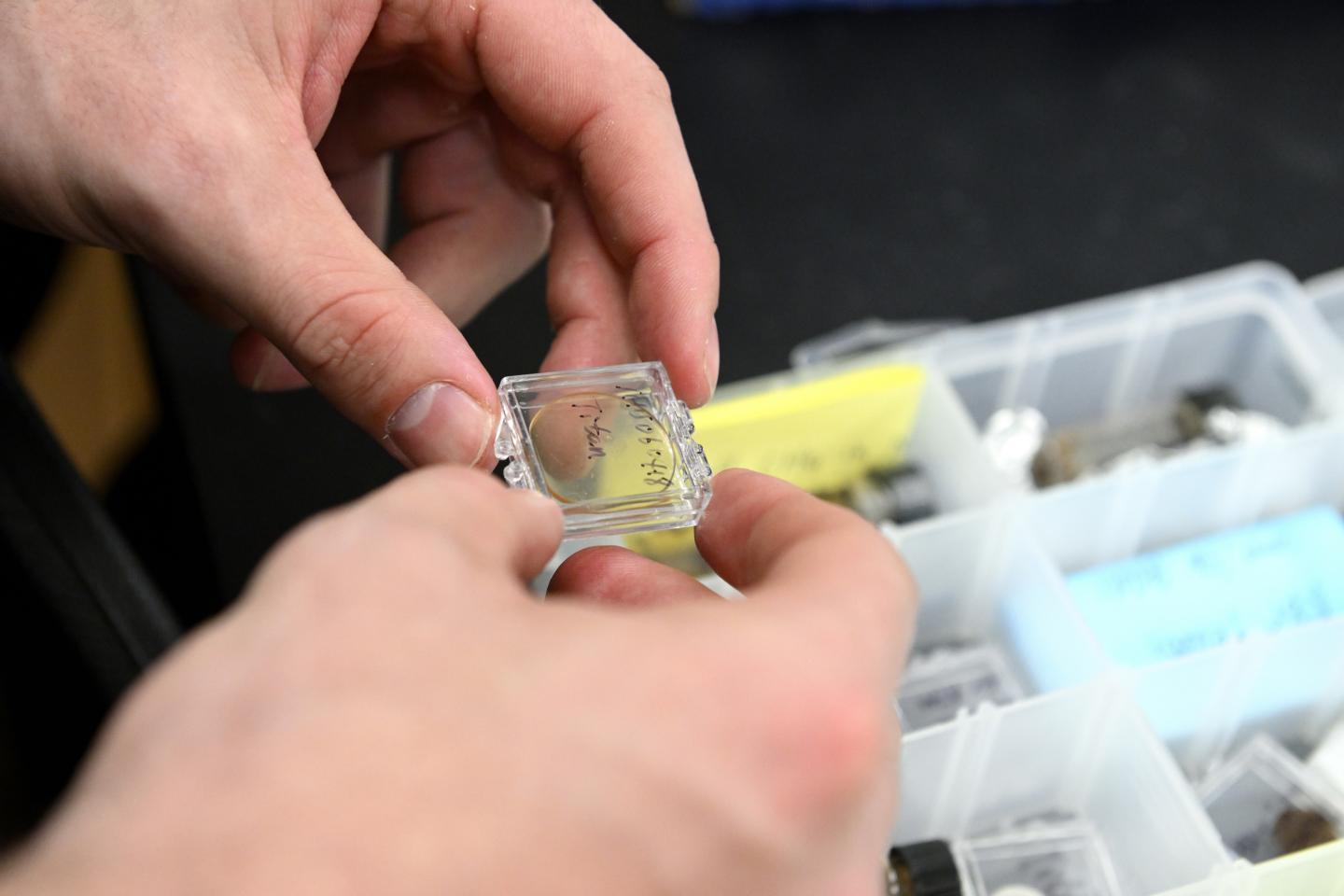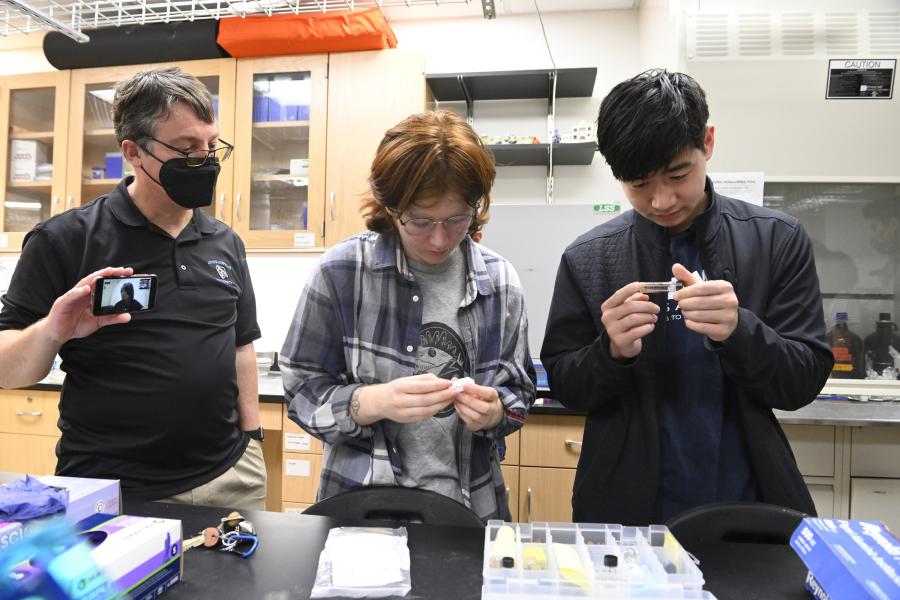- Name
- Roberto Molar Candanosa
- rmolarc1@jh.edu
- Office phone
- 443-997-0258
- Cell phone
- 443-938-1944
Many of us know about the slew of missions underway to the moon and to Mars. Few are aware, however, of the handful of missions planned to our next-door planetary neighbor: Venus.
Located some 38 million miles from Earth, Venus is the hottest planet in our solar system, with a greenhouse effect that traps heat to such an extent that average temperatures are a stifling 870 degrees Fahrenheit. Humans cannot survive amid this inferno, yet scientists suspects the planet "may have been the first habitable world in the solar system, complete with an ocean and Earth-like climate," according to NASA. What happened, then, to alter the course of our cosmic neighbor so drastically?

Image caption: Students in the Spacecraft Instrumentation Project course visit Sarah Hörst's lab in Olin Hall
Image credit: Will Kirk / Johns Hopkins University
Through their involvement in a NASA mission known as DAVINCI (Deep Atmosphere Venus Investigation of Noble Gases, Chemistry, and Imaging), students at Johns Hopkins University are helping to find clues to the planet's mysterious evolution. The mission aims to answer questions like: Did Venus ever harbor life? How did Venus and Earth, which are similar in size and density, end up being so different? What can the atmospheric composition of Venus teach us about the planet's origin and evolution?
Undergraduate students working on the project are enrolled in a semester-long course, Spacecraft Instrumentation Project, offered for the first time this spring by the university's Krieger School of Arts and Sciences, and to be offered every semester moving forward. Unlike most science and engineering courses, this one positions students as the conductors of a real-life mission, working under the guidance and oversight of faculty to design, test, and operate an oxygen sensor that will be used on an upcoming robotic expedition to Venus. Students can also apply for internships and teaching assistantships—and continue working on DAVINCI after the course ends.

Image credit: Will Kirk / Johns Hopkins University
Noam Izenberg, a planetary geologist at Johns Hopkins' Applied Physics Laboratory, spearheaded the multiyear effort to make Johns Hopkins a partner institution of NASA's DAVINCI mission, which is currently scheduled to launch in 2031, Izenberg says. He serve as the project lead of the university's part of DAVINCI and is also leading the new course.
Other scientists and engineers who developed and now help run the project and co-teach the course include Sarah Hörst, a planetary scientist and associate professor in the Krieger School's Department of Earth and Planetary Sciences; and David Kraemer, a mechanical engineer and an associate teaching professor at the Whiting School of Engineering. In addition, Stergios Papadakis, an electrical engineer and principal staff scientist at APL, plays a key role as a systems engineer for the instrumentation.
When the team proposed the project to NASA, "we didn't want to end up with something that required faculty and mission engineers to be overly involved in the work and process," Izenberg explains. "Instead, we intentionally chose a project that didn't require scads of prior knowledge—and that students with broad science and engineering experience could effectively accomplish."

Image caption: David Kraemer shares tips with the class
Image credit: Will Kirk / Johns Hopkins University
Hörst adds: "The class is multidisciplinary, with students majoring in various areas of science and engineering—physics, computer science, data science, mechanical engineering, systems engineering. All of their specialties are needed." Regarding the class objectives, "learning to communicate and work together effectively, despite having different skills and interests—this is the real goal of the course," says Izenberg. Another goal is for students to experience the facets and flow of a space mission, especially "how the mission's science objectives are created, and how the spacecraft and sensors are developed, tested, and refined," he adds.
Kraemer, the project's mechanical engineer, says he considers the current year "an exciting and ideal time to launch a course like this, given the many private companies partnering with NASA and [accelerating] space exploration.
"We have students [and alumni] working and interning at companies like Blue Origin and SpaceX," he continues. "They need engineers and other people who can develop things quickly, and this course is a great [launchpad] for that. The assignments [consist of] real stuff that needs to happen for a real mission. They're not busy work."
What the mission entails
NASA's DAVINCI mission aims to measure the composition of Venus' dense atmosphere and confirm whether the planet ever had an ocean, as scientists suspect. Johns Hopkins' portion of the project, meanwhile, focuses specifically on a part of the mission known as VfOx (Venus Oxygen Fugacity), for which students are developing a sensor to gauge the amount of oxygen in Venus' lower atmosphere.
"VfOx will measure oxygen much like the sensors used in [internal combustion] cars measure oxygen—in this sense, the technology already exists to measure oxygen at high temperatures," Hörst says. But the class can't just take a car sensor and send it off to Venus, she suggests. Instead, they must adapt the design and materials so the sensor can survive in the planet's harsh environment.

Image credit: Will Kirk / Johns Hopkins University
"The Venusian atmosphere is made mostly of carbon dioxide, and the surface temperature is so hot that some metals will melt," explains Hörst. Another challenge is the planet's thick clouds that consist largely of sulfuric acid, which can dissolve metals and burn holes through human skin. "The trip through the upper atmosphere will be rocky, and the sensor will need to survive that to reach its destination in the lower atmosphere," she says.
Right now, the sensor design consists of layers of ceramic that can withstand high temperatures but could potentially fracture when rattled on the turbulent journey, Kraemer explains. "Students will need to determine: Can this design get the job done, or do we need to change it?" he says.
A look inside the class
In the course's weekly seminar, students listen intently one morning as Izenberg gives his feedback on a group assignment: an analysis of potential VfOx risks. "Risk management is largely a project management process; it's also an iterative process," Izenberg tells the class.
A panel of engineers from NASA's Goddard Space Flight Center in Greenbelt, Maryland, tune in on a jumbo screen, attending the class remotely to weigh in and answer questions. "All of the risks you identified [in the assignment] describe some sort of failure with the [sensor] wire," Izenberg says to students.
Turning to the panel for guidance, he asks: "How specific do we need to be [in our risk analysis] about the modes of failure with the wire?"
A response comes from Matt Garrison, a payload systems engineer on NASA's DAVINCI team, who advises the class "to differentiate, to identify, the specific failures [and determine, for instance]: Is this a workmanship failure or a design failure?" The seminar continues, with Izenberg and his students talking through potential VfOx risks, and Garrison and his colleagues chiming in with insight and advice.

Image caption: Michael Radke, a postdoctoral fellow in the Department of Earth and Planetary Science at Johns Hopkins, and Sarah Hörst discuss the Venus mission with students
Image credit: Will Kirk / Johns Hopkins University
Izenberg ends the class by introducing an assignment—designed to take several weeks, he says—to write a test analysis plan for VfOx. "Imagine that once you write this test, you will be asked to perform this test to validate VfOx," he tells them. Testing will take place at APL, home to the Venus Environment Chamber, a simulation vessel that mimics the pressure, temperature, and atmospheric composition of Venus.
Students are eager to try it out.
"I never imagined having access to places like APL and Goddard as an undergraduate," Jeevika Setzer, a first-year student double-majoring in electrical engineering and physics, says after the class. "The access is incredible—access to labs and [testing equipment], plus access to the Goddard experts who show up in person and by Zoom to talk to our class, and to the professors with decades of experience on space missions teaching our class."
Though Setzer doesn't yet know whether she wants to pursue a career in space engineering, she says the course will help her decide, and the skills she's gaining there are transferrable. "I'm also interested in biomedical engineering, but biomedical devices and technologies—nearly all devices and technologies, really—have sensors, so everything I'm learning in this course can help regardless of what I end up doing."

Image credit: Will Kirk / Johns Hopkins University
Likewise, she's sharpening skills in Python, the computer programming language she's using to write scripts to analyze VfOx data. "Using my own code has made the analysis easier," she says, adding that it also lets her build on what she's learning in her Python class.
Kyle Dalrymple, a junior pursuing a major in mechanical engineering and a minor in space science and engineering, says the class and the summer internship he completed last year, when he worked with Izenberg and other VfOx team members—and started the process to secure a second Venus simulation vessel for Johns Hopkins' Homewood campus—has been a game-changer.
"I absolutely love space science and space engineering … and originally thought I needed to pick [just one of these areas to pursue]," Dalrymple said. "To know there's an intersection between the two, and it's not just a niche intersection but something that is thriving, really helps me go down a career path that is very congregate with my interest. This is a huge takeaway."
Dalrymple says he initially worried whether the course would be a "a student collaboration project, with the professor[s] just telling you what to do, … or are you going to be set free on the opposite end of the spectrum, with no guidance?
"Neither has happened," he says. Instead, "there's been a great balance between professor supervision and oversight, and in allowing students to drive the science and engineering … and [stay] very involved in iterating the design."
Will DAVINCI will help crack the code on Venus?
For Dalrymple, "space missions don't necessarily do what they're intended to do exclusively," he says. Data gathered from missions often ends up leading to "insights and conclusions that [scientists didn't] initially set out to make. That's the most exciting part of science in general for me."
Though Dalrymple and Setzer will have long graduated from Johns Hopkins when DAVINCI sets off to Venus, they both say they plan to stay attuned to information about the mission launch and connected to the VfOx team and project. Faculty overseeing the project wouldn't have it any other way, they say.
"Our philosophy is that no matter what students are doing with their professional lives, they'll be invited back after the launch and given an opportunity to get involved," Izenberg says.
"Maybe they'll be data analysts, maybe they'll be teachers, or computer scientists, accountants, engineers, or even bakers—whatever the case, they're part of our team and can contribute."
Posted in Science+Technology, Student Life
Tagged applied physics laboratory, space








